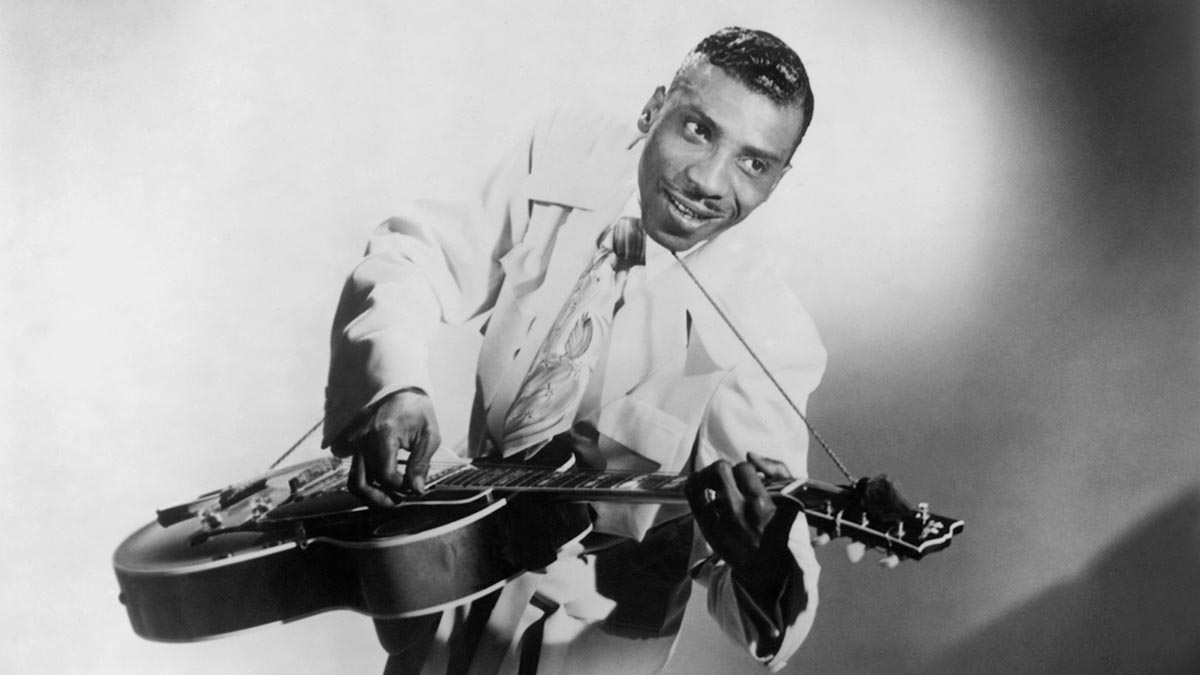Introducing jump blues, the pioneering guitar style that set the scene for rock ’n’ roll by melding swing, jazz and blues
Exemplified by the likes of Louis Jordan, Roy Brown and T-Bone Walker, jump blues can add some jazz flair to your blues and rock ‘n‘ roll changes

Jump blues was a style of music that developed in the 1940s and was an offshoot of the big bands of the day. It was essentially an uptempo swing combining jazz, boogie and blues that was popular in dance halls.
Predating rock and roll by a few years, jump blues bands were smaller than their big band counterparts and tended to consist of vocals, drums, upright bass, piano and a small horn section of saxophones and trumpets. Sometimes there would be an electric guitar, too.
The lead singer was often a horn player, and the horns usually played the instrumental melodies and solos. The style was pioneered by artists like Louis Jordan and His Tympany Five (Jordan was the vocalist and lead sax player) with songs like Choo Choo Ch’Boogie and Saturday Night Fish Fry.
Roy Brown, another jump blues artist had a hit with Good Rockin’ Tonight (recorded in 1947) which has been argued as perhaps the first rock and roll song, while Louis Prima’s Jump Jive an’ Wail is an absolute classic.
As the development of the electric guitar allowed the instrument to be heard and compete with louder instruments in dance halls, it’s no surprise that it too became a lead voice, and in the late 1940s and into the ’50s.
Artists like Tiny Grimes, T-Bone Walker, Bill Jennings, Peppermint Harris and Hollywood Fats played wonderful guitar licks and solos incorporating major and minor pentatonic-fuelled blues lines, often combined with jazz phrases too. Notable guitar players of later years and today have carried the torch of this infectiously appealing genre; virtuosi such as Brian Setzer, Duke Robillard, Junior Watson and Chris Corcoran.
In this feature, I have written two jump blues style pieces; one in a major key and the other minor. Although jump blues tunes are much more commonly heard in major keys due to the upbeat, dance orientated nature of the genre, if you hunt for them, you can find some minor key tunes such as Peppermint Harris’s, I Cry For My Baby, and Louis Jordan’s Is You Is Or Is You Ain’t My Baby.
In addition, I have tabbed out five major and five minor jump blues licks to introduce the type of vocabulary you will encounter on entering this fascinating world.
Our two pieces go beyond regular 12-bar blues style chord changes and are therefore more harmonically challenging, drawing on the jazz influence that can be heard in many jump blues tunes.
So, as well as containing staple major and minor Pentatonic lines, you’ll also find a number of jazzier elements here, such as chromatic lines and altered notes like the b5th, as well as techniques that might be more associated with rock and roll and electric blues guitar, such as double-stops and bends. Happy jivin’!
Get the tone
Amp Settings: Gain 3, Bass 4, Middle 6, Treble 6, Reverb 5
A straightforward clean tone is all that’s necessary here. Humbuckers weren’t yet invented when jump blues was born, but of course both they and single-coil pickups will do the job fine, with maybe a tiny amount of overdrive to give the effect of a small guitar amp being cranked. Add some reverb for ambience and perhaps some slapback delay like Brian Setzer.
Major licks
Lick 1. Chromatic encirclement
This line, played over a B6 chord, repeats over three descending octaves and features chromatic encirclement of the major 3rd interval (D# note), between the b3rd (D note) and the 4th (E note).
Lick 2. Mixing pentatonics and chromatics
This lick mixes B major pentatonic (B-C#-D#-F#-G#) and B minor pentatonic (B-D-E-F#-A) scales, but also demonstrates how a chromatic line going from the major 2nd interval (C# note, 6th fret, third string) up to the 5th (F# note) creates a great jazzy sounding line that you can add into your blues playing.
Lick 3. Sliding into chords
This chordal approach to the I and IV chords (B6 and E9 respectively) gives an exciting and very ‘vintage’ type sound, and creates an entirely different flavour to the usual melodic single-note line approaches. Make sure the chords are played staccato. Perhaps surprisingly, you can hear this approach in reggae, too.
Lick 4. Double-stops
A similar idea to the one seen in lick 3, this idea sees double-stop ideas being used throughout the phrase. This can be a useful approach to thicken up the sound, especially in a bass, drums, guitar type of three-piece setup.
Lick 5. Incorporating the flat 5 note
This jazzy sounding lick is played over a B6 chord and features the use of the b5th interval (F note). This note comes from the B Lydian dominant mode (B-C#-D#-E#/F-F#-G#-A), but can be ‘borrowed’ as a single note and mixed with regular major and minor pentatonic vocabulary to produce a jazz-blues effect.
Minor licks
Lick 1. Blues scale lick
This is a repeating G minor blues scale (G-Bb-C-Db-D-F) motif over three descending octaves. Enjoy the slinky slides and pull-offs!
Lick 2. Triadic inversions
Bars 1- 2: This is a triad based phrase which starts with a G minor triad (G-Bb-D), then moves through D augmented (D-F#-A#) to Bb major (Bb-D-F). The inversions of the triads here create a descending line which gives the sound of a G minor (G-Bb-D), Gm/maj7 (G-Bb-D-F#) and a Gm7 (G-Bb-D-F).
The E note on beat 3, bar 2, completes this line giving the sound of a G6 chord (G-Bb-D-E). You’ll notice a lot of 6th chords in jump blues, often favoured over dominant 7ths as I chords.
Lick 3. Minor line with chromatics
This is a quirky descending chromatic line in G minor which marks the 5th (D note), 4th (C note), b3rd (Bb note) and 2nd (A note) of a G Aeolian (G-A-Bb-C-D-Eb-F). The G minor blues scale line which follows, brings a bluesy familiarity back to the whole phrase. Make sure the pull-offs are played cleanly.
Lick 4. Bluesy lick with outside notes
This lick features a typically bluesy phrase to begin with, from G minor pentatonic scale (G-Bb-C-D-F). Make sure the D notes (10th fret, first string) are fretted firmly so they remain ringing while the Bb notes (11th fret, second string) are bent slightly sharp (often called the blues ‘curl’). The phrase in bars 3-4 is played over an Eb7 chord (Eb-G-Bb-Db) and comes from the Eb Lydian Dominant mode (Eb-F-G-A-Bb-C-Db).
Lick 5. Chord substitution with jazzy slides
The purpose of this lick is to show how a succession of diminished 5th interval shapes can be substituted for a dominant chord (Root, 3rd, 5th, b7th) to mark the major 3rd and b7th. Playing a slide from the note a semitone below the starting note of each shape gives a jazzy sound to the idea.
Major Solo
Bars 1-5: Mainly based on the B major pentatonic scale (B-C#-D#-F#-G#), note how the major 6th interval (G# note, 9th fret, second string) becomes the Major 3rd of the E7 chord (E-G#-B-D) in bar 2. In bar 5, the b5th interval (F note, 6th fret, second string) is briefly played which gives a jazzy feel over the B7 chord. This note comes from the B Lydian dominant mode (B-C#-D#-E#-F#-G#-A).
Bars 5-8: Bar 6 sees an Fdim7 arpeggio played over the Fdim7 chord (F-Ab-C-Ebb). The descending motif line in bars 7 and 8 follow the chromatic movements of the chords, and feature the 5th, 6th and 3rd of each chord.
Bars 9-12: The line in bar 9 comes from the C# melodic minor scale (C#-D#-E-F#-G#-A#-B#) and is played over the II chord, C#m7. The chromatic style line over the V chord (F#7) in bar 10 leads into the T-Bone Walker style bluesy idea in bars 11-12.
Bars 13-14: This is a typical type of up tempo ending lick which finishes on a double stop featuring the major 3rd (D# note) and 5th (F# note) of a B6 chord. Many if not most of these ideas will fit over regular blues styles to both lift and excite them.
Minor Solo
Get The Pick Newsletter
All the latest guitar news, interviews, lessons, reviews, deals and more, direct to your inbox!
Andy Saphir has been a professional guitar player and teacher for over 25 years. Graduating with distinction from London’s prestigious Guitar Institute in 1995, he has gone on to gain a reputation as one of the UK’s top country guitarists. Specialising in country and blues, Andy is a versatile, multi-genre player and has a successful international performing career, touring with numerous shows and bands, including the Blues Brothers Approved. Andy taught on the guitar faculty at London’s ICMP for many years, and is a longtime contributor to Guitar Techniques Magazine, as well as being a Jam Track Central artist. Andy teaches in-person guitar lessons from Cambridgeshire UK, or remotely globally.
“There are so many sounds to be discovered when you get away from using a pick”: Jared James Nichols shows you how to add “snap, crackle and pop” to your playing with banjo rolls and string snaps
Don't let chord inversions bamboozle you. It's simply the case of shuffling the notes around










![Joe Bonamassa [left] wears a deep blue suit and polka-dotted shirt and plays his green refin Strat; the late Irish blues legend Rory Gallagher [right] screams and inflicts some punishment on his heavily worn number one Stratocaster.](https://cdn.mos.cms.futurecdn.net/cw28h7UBcTVfTLs7p7eiLe.jpg)


![A black-and-white action shot of Sergeant Thunderhoof perform live: [from left] Mark Sayer, Dan Flitcroft, Jim Camp and Josh Gallop](https://cdn.mos.cms.futurecdn.net/am3UhJbsxAE239XRRZ8zC8.jpg)